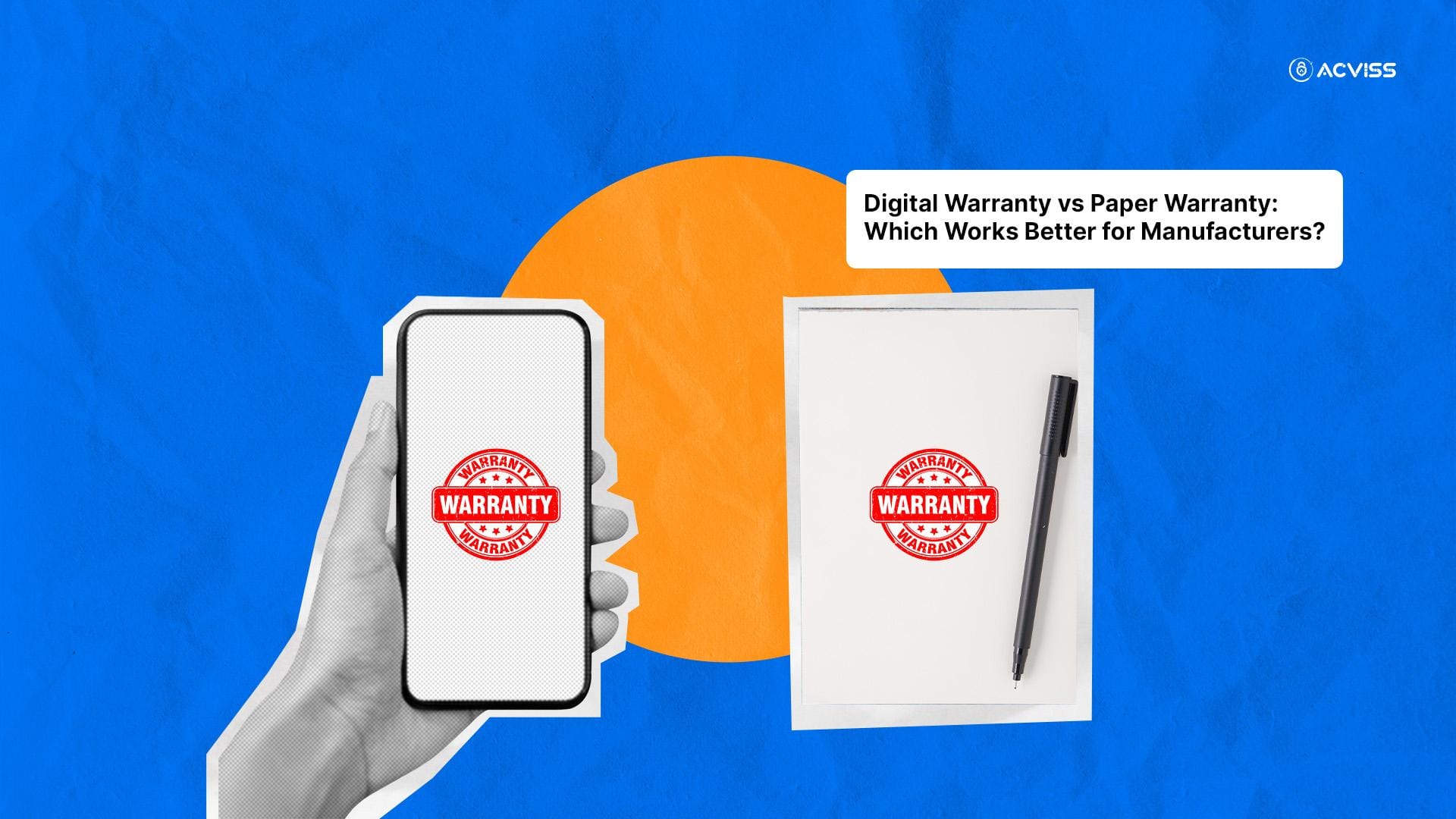Digital Warranty vs. Paper Warranty: Which Works Better for Manufacturers

For decades, a warranty card has been more than a piece of paper. It has symbolised assurance, quality and the promise of trust between manufacturers and consumers. But as the world has moved toward digitalisation, the traditional paper warranty is being challenged by a new contender, the digital warranty.
This transition is not just about moving from a physical format to a virtual one. It represents a broader shift in how manufacturers engage with their customers, manage after-sales service, protect their brand integrity, and ensure compliance across increasingly complex supply chains.
So, what truly works better for manufacturers today, paper or digital warranties? Let’s explore this question through the lens of brand protection, traceability, customer engagement, and operational efficiency, drawing insights from current industry trends and technological advancements.
The Role of Warranties in the Manufacturing Ecosystem
A product warranty is a commitment, a formal declaration that a brand stands by its product’s quality and performance. Traditionally, it has served three key functions:
- Building trust – Customers perceive brands that offer warranties as more reliable.
- Providing protection – Warranties give consumers assurance against product defects or failures.
- Creating post-purchase engagement – It opens a communication channel between the manufacturer and the customer for future services, upgrades, or feedback.
However, as the product landscape evolves, so does consumer expectation. The rise of e-commerce, the omnichannel retail model, and the globalisation of supply chains have made warranty management far more complex than before.
Paper-based systems, once sufficient, are increasingly falling short in delivering the level of efficiency, traceability and customer satisfaction that modern markets demand.
The Problem with Paper Warranties

Paper warranties have been the norm for decades, but their limitations are becoming more apparent in a data-driven economy.
1. Loss and Mismanagement
Most customers either misplace their warranty cards or forget to register them. A 2019 consumer report found that nearly 40% of buyers fail to retain physical proof of purchase or warranty cards within six months of purchase. This creates frustration for both the consumer and the brand’s service teams.
2. High Administrative Costs
Paper-based warranties involve manual record-keeping, storage, and verification processes. For manufacturers managing millions of products, this can result in enormous administrative overheads.
3. Fraud and Counterfeiting Risks
Paper warranties are easily duplicated or forged. Unscrupulous sellers often exploit this by selling counterfeit products with fake warranty cards, eroding customer trust and damaging brand reputation.
4. Lack of Real-Time Data
Paper systems cannot capture live data on customer behaviour, claim patterns or product performance. This leaves manufacturers operating in the dark, unable to make informed decisions about product quality or customer engagement.
5. Environmental Impact
The manufacturing, printing and distribution of paper warranties contribute to unnecessary waste and carbon emissions, making them increasingly incompatible with sustainability goals.
The Digital Shift: Understanding Digital Warranties
Digital warranties are electronic records that replace the traditional paper card. They integrate seamlessly with a brand’s CRM, supply chain management, and after-sales systems, enabling real-time verification, claim processing and product traceability.
Unlike a paper card that requires physical storage, a digital warranty lives in the cloud, accessible anytime, anywhere, and secured using modern authentication technologies such as QR codes, blockchain, and non-cloneable labels.
A 2023 study by Statista highlighted that over 65% of manufacturers worldwide are investing in digital warranty management platforms to enhance operational transparency and customer satisfaction.
Why Digital Warranties Are Transforming Brand Protection

1. Enhanced Product Authentication
Digital warranties allow instant verification of product authenticity through a scan. Each product carries a unique, non-cloneable code, which, when scanned, confirms its genuineness.
Solutions like Acviss Certify make this possible. Using non-cloneable, tamper-proof digital identifiers, Certify enables customers to verify product authenticity instantly and securely. This directly combats counterfeiting, one of the biggest threats to global brands.
2. Real-Time Brand Protection
By integrating digital warranties with anti-counterfeiting technologies and traceability systems, manufacturers gain end-to-end visibility across their supply chains. From the factory floor to the customer’s hands, every transaction and transfer is recorded, strengthening brand authentication and IP protection.
3. Reduced Warranty Fraud
With paper warranties, fraudulent claims are often hard to detect. In contrast, digital warranty programs allow each claim to be tracked and validated against a secure database, ensuring that only legitimate customers receive service.
Solutions such as Acviss Assist enable brands to verify warranty claims, preventing unauthorised requests and duplicate claims. This not only saves costs but also preserves service quality for genuine customers.
Traceability: The Backbone of the Modern Warranty Ecosystem
Traceability and warranty management go hand in hand. A warranty is not merely a promise; it’s a data point that ties back to a product’s journey across the supply chain.
With track and trace solutions, manufacturers can:
- Identify where a product was made, stored and sold.
- Track its authenticity through the entire distribution network.
- Analyse warranty claim data to identify recurring defects or geographic trends.
For instance, a track and trace system integrated with blockchain ensures immutable recording of product movement, helping brands maintain accountability and transparency. When combined with digital warranties, this creates a powerful framework for product traceability, brand verification, and consumer trust.
Customer Engagement and Satisfaction Through Digital Warranties
Modern consumers expect seamless, digital-first experiences. A paper card that requires manual registration feels outdated in an era where everything from banking to grocery shopping happens online.
1. Simplified Registration
Digital warranties allow users to register products via a QR code scan, reducing friction and improving participation rates.
2. Personalised Engagement
With digital systems, brands can engage customers post-purchase with tailored notifications, service reminders, and loyalty offers. These touchpoints strengthen the relationship between brand and consumer, enhancing brand loyalty and customer satisfaction.
3. Faster Service Resolution
In traditional systems, service centres often struggle to verify warranty validity. A digital platform instantly pulls up product and purchase data, enabling faster claim resolution and improving customer trust.
A report by McKinsey (2022) found that companies using digital warranty management experienced a 25% improvement in customer satisfaction scores compared to those relying solely on paper processes.
The Supply Chain Connection
Warranty data can be a goldmine for supply chain management. Analysing warranty claims helps identify recurring defects, design flaws, or supplier inconsistencies.
Digital warranty systems integrated with track and trace allow manufacturers to:
- Detect quality issues earlier in the production process.
- Streamline recall procedures with precision.
- Improve collaboration with suppliers through shared data insights.
This level of transparency is impossible to achieve with disconnected, paper-based systems. In essence, a digital warranty is not only a customer service tool but also an enabler of smarter supply chain management.
Security, Privacy and IP Protection

Digital warranties also play a crucial role in trademark and IP protection. Counterfeiters often imitate packaging and labelling, but replicating a secure digital warranty linked to a verified product database is nearly impossible.
By using non-cloneable technology and secure QR codes, manufacturers ensure that each product is digitally registered in a tamper-proof ecosystem. This not only safeguards the brand’s intellectual property but also reassures consumers that what they have purchased is genuine.
A well-structured brand protection strategy built around digital warranties, anti-counterfeiting solutions, and traceability technologies creates a closed loop of security, protecting the brand’s identity, reputation and legal standing.
The Economics of Transition: Cost vs. Value
Many manufacturers hesitate to move from paper to digital due to perceived costs. However, a closer analysis reveals that the ROI from digital warranty management far outweighs the initial investment.
Cost Savings
- Reduction in printing and distribution costs.
- Lower administrative overheads.
- Minimised fraudulent claims.
Value Creation
- Enhanced brand trust and verification.
- Better customer retention through data-driven engagement.
- Stronger compliance and product traceability.
A 2024 survey by Gartner noted that manufacturers adopting digital warranty systems saw a 30–40% reduction in operational costs within the first two years.
Regulatory and Sustainability Drivers
Governments and industry regulators are increasingly promoting digital-first documentation for compliance and environmental reasons.
Digital warranties support:
- Regulatory compliance through automated record-keeping.
- Sustainability goals include eliminating paper waste.
- Transparency in warranty management and claim auditing.
This aligns with global trends in product safety and brand accountability, particularly in industries such as electronics, automotive, and pharmaceuticals.
Challenges in Adopting Digital Warranties
Despite their benefits, transitioning to digital warranties comes with its own set of challenges.
- Integration Complexity – Aligning digital warranties with legacy ERP and CRM systems requires strategic planning.
- Consumer Awareness – Some customers still expect a physical proof of warranty, so brands must educate them about the benefits of digital systems.
- Data Security – Protecting customer data and ensuring GDPR compliance is critical.
However, these challenges can be mitigated with the right technological partner. Advanced brand protection solutions such as those from Acviss ensure secure integration, compliance and scalability, empowering manufacturers to modernise without compromise.
Real-World Impact: How Brands Are Benefiting
Several global brands have already transitioned to digital warranty programs with remarkable results.
- A leading electronics manufacturer reduced fraudulent warranty claims by over 60% using product authentication and digital registration.
- An automotive OEM integrated digital warranties with its track-and-trace system to identify recurring defects and strengthen supplier accountability.
- A consumer appliances brand enhanced its after-sales engagement by offering instant digital warranty registration, improving customer satisfaction scores by 35% within six months.
These success stories highlight the growing significance of digital warranties as both a customer engagement and brand protection tool.
The Future: Digital Warranties as a Data Ecosystem

The next evolution of warranty management will go beyond digitisation. The focus will shift towards data-driven intelligence, where warranty information is leveraged to enhance design, quality control and customer experience.
- AI and machine learning will analyse warranty claim patterns to predict potential failures.
- Blockchain will ensure transparent, immutable warranty records.
- IoT-enabled devices will automate product registration upon activation, further simplifying the user experience.
In this connected ecosystem, the digital warranty will become a vital node, not just a record of protection, but a driver of continuous improvement, innovation and trust.
Conclusion
So, which works better for manufacturers, a digital warranty or a paper warranty?
The answer lies in the evolving priorities of modern manufacturing. While paper warranties served their purpose in the past, they no longer align with the speed, scale and sophistication of today’s supply chains and customer expectations.
Digital warranties, when backed by brand protection solutions, track and trace technologies, and non-cloneable authentication systems like Acviss Certify and Acviss Assist, offer manufacturers far more than convenience. They deliver security, transparency, and long-term customer trust.
For manufacturers seeking to future-proof their operations, strengthen IP protection, and engage customers more meaningfully, digital warranties are not an option; they are a necessity.
Interested to learn more about how digital warranties and traceability solutions can strengthen your brand protection strategy? Get in touch with us and discover how technologies like Certify and Assist can redefine your warranty experience.
